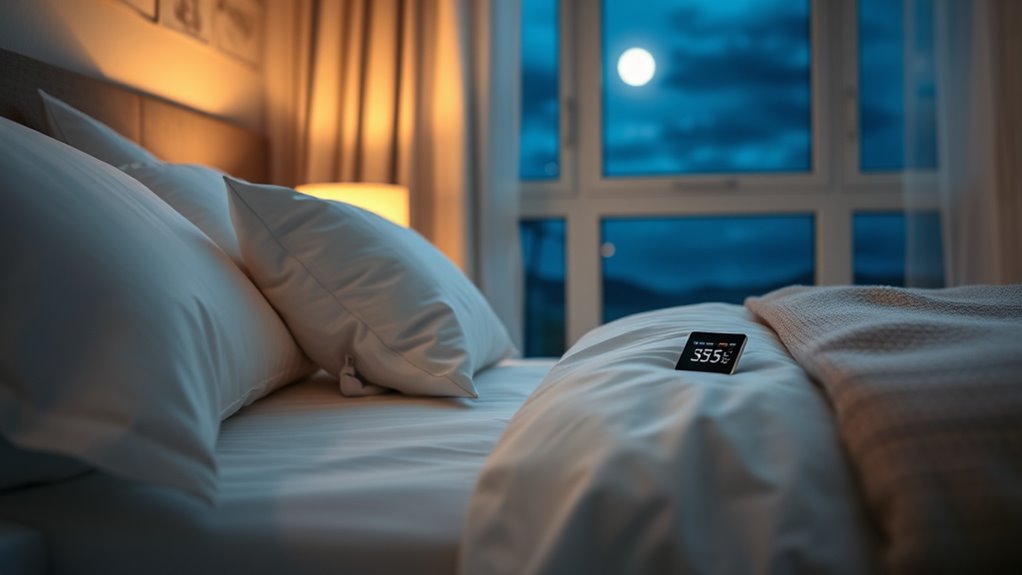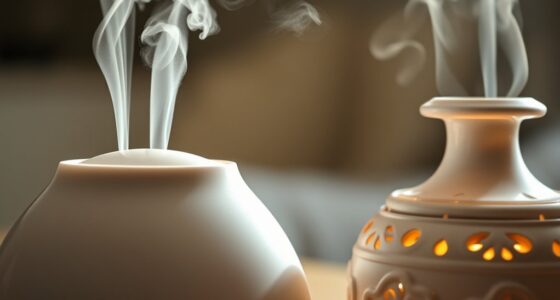To get the best sleep, keep your bedroom between 60-67°F (15-19°C), as cooler temperatures help your body produce melatonin and shift into restful deep sleep. Your body naturally drops in temperature at night, signaling sleep onset, so maintaining an environment within this range supports this process. Personal comfort varies, and proper bedding and airflow are key. If you want to optimize your sleep environment further, you’ll find useful tips and insights below.
Key Takeaways
- Optimal sleep temperature (60-67°F) supports melatonin production, promotes deep sleep, and aligns with circadian rhythms for restorative rest.
- Cooler environments facilitate faster sleep onset and improve sleep quality by regulating core body temperature naturally.
- Excessively warm or cold rooms disrupt sleep cycles, cause discomfort, and fragment deep sleep stages.
- Personal comfort varies; adjusting bedding, sleepwear, and airflow is essential for maintaining ideal sleep conditions.
- Technological tools like smart thermostats and sleep trackers help optimize bedroom temperature for better sleep health.
The Science Behind Body Temperature and Sleep Cycles

Understanding how your body temperature fluctuates is key to grasping sleep cycles. Your body relies on thermoregulation mechanisms to maintain a stable core temperature, which naturally drops at night to signal sleep onset. This temperature decline is synchronized with your circadian rhythm, ensuring that your sleep-wake cycle aligns with day and night. During the evening, your body actively cools down by redistributing heat, helping you fall asleep faster. Conversely, as morning approaches, your body temperature rises, promoting wakefulness. This interplay between thermoregulation and circadian rhythm alignment is essential for restful sleep. When your body temperature follows its natural pattern, you experience more restorative sleep stages and wake feeling refreshed. Proper temperature regulation supports your overall sleep quality and health.
How Temperature Affects Melatonin Production
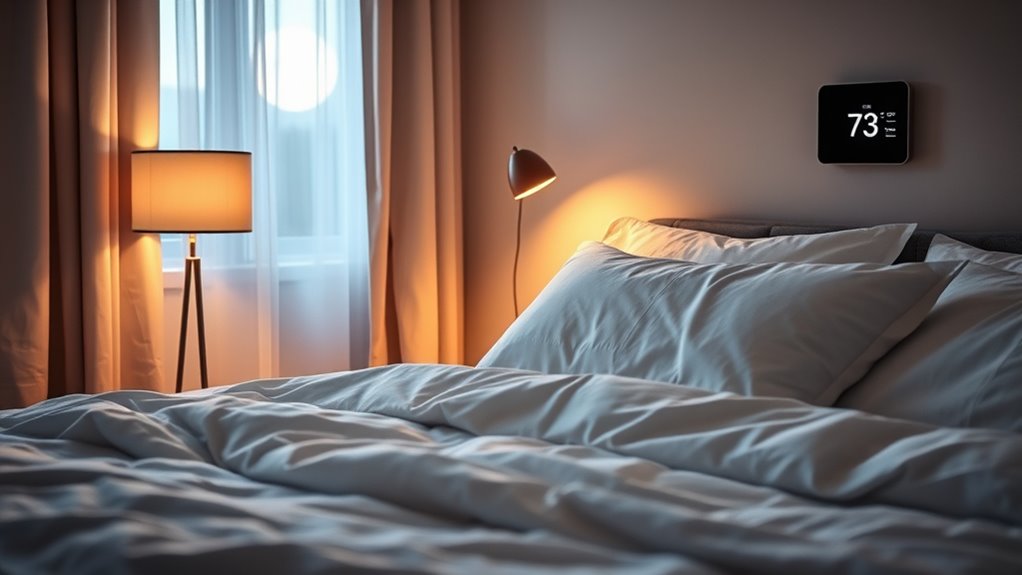
Have you ever wondered how your body’s temperature influences melatonin production? Your body’s core temperature plays a vital role in melatonin synthesis, which is essential for sleep regulation. Cooler temperatures signal your brain that it’s time to produce melatonin, supporting circadian regulation. When your environment is too warm, this process slows down, making it harder for your body to initiate sleep. Conversely, a slightly cooler temperature helps facilitate melatonin release, promoting restful sleep. Your body’s ability to regulate temperature effectively impacts the timing and amount of melatonin produced, directly influencing sleep quality. Maintaining an ideal sleep temperature ensures your circadian rhythms stay synchronized, allowing melatonin to do its job in preparing your body for restorative sleep.
The Ideal Bedroom Temperature for Different Sleep Stages
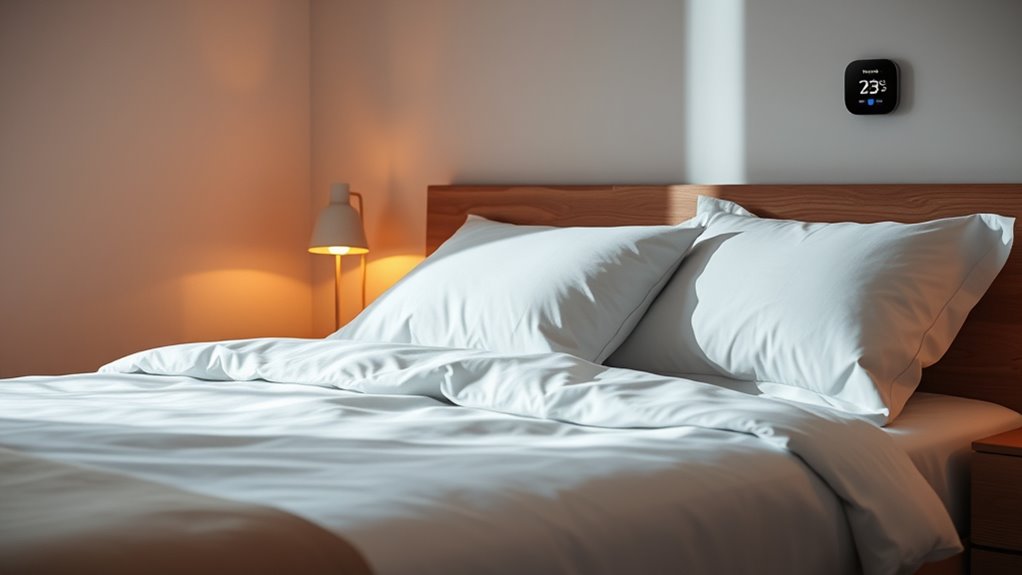
Your bedroom temperature can substantially impact each sleep stage, especially light and deep sleep. Maintaining the right range helps you stay in lighter stages longer and reach restorative deep sleep more effectively. Let’s explore the ideal temperatures for optimizing these critical phases of your sleep cycle.
Light Sleep Temperature Range
Maintaining the right bedroom temperature during light sleep stages is essential for a restful night, as different sleep phases respond best to specific temperature ranges. Proper temperature regulation enhances sleep comfort and helps you stay in light sleep longer without disruptions. Generally, the ideal light sleep temperature range is between 60°F and 67°F (15.5°C–19.5°C). Keep these points in mind:
- Cooler temperatures promote quicker shift into deep sleep.
- Slightly warmer zones can help you relax into light sleep more easily.
- Avoid sudden temperature fluctuations that disturb sleep comfort.
- Use breathable bedding to optimize temperature regulation during light sleep.
Staying within this range supports your body’s natural sleep cycles and prevents overheating or chilling, ensuring a more restful, uninterrupted night.
Deep Sleep Optimization
Achieving perfect deep sleep depends heavily on controlling your bedroom temperature, as this stage responds best to cooler environments. When your thermal comfort is optimized, your body produces more sleep hormone melatonin, aiding deep restorative rest. The ideal temperature for deep sleep is typically around 60-67°F (15-19°C). Imagine your sleep environment like this:
| Temperature Zone | Sensory Comfort | Sleep Hormone Response |
|---|---|---|
| Too Warm | Sweaty, restless | Reduced melatonin, disrupted deep sleep |
| Ideal (60-67°F) | Calm, cozy | Increased melatonin, deep restorative sleep |
| Too Cold | Chilly, uncomfortable | Sleep disturbances, fragmented deep sleep |
Maintaining this range enhances thermal comfort, supporting your body’s natural sleep processes and deep sleep cycles.
Common Myths About Sleep Temperature Debunked

Many common beliefs about sleep temperature are actually myths that can hinder restful nights. Don’t fall for these temperature misconceptions that sleep myths often promote:
- You need a hot room to sleep well—actually, cooler environments promote better sleep quality.
- Everyone sleeps best at the same temperature—personal comfort varies widely.
- Warming your room helps you fall asleep faster—optimal sleep occurs at cooler, but comfortable, temperatures.
- You should keep your thermostat constant—fluctuating temperatures can disrupt your sleep cycle.
Understanding these sleep myths is key to improving your sleep environment. Debunking these misconceptions helps you create a space that’s tailored to your needs, rather than relying on outdated ideas that might be keeping you from restful nights.
The Impact of Temperature on Sleep Quality and Duration

Your sleep quality and how long you stay asleep are directly affected by your room’s temperature. When the environment is too hot or cold, your sleep cycles can become disrupted, leaving you tired in the morning. Finding the ideal sleep environment helps you rest better and wake up feeling refreshed.
Temperature and Sleep Cycles
Temperature plays a vital role in shaping your sleep cycles, directly affecting both sleep quality and duration. When your sleep environment isn’t properly temperature-controlled, your body struggles to progress smoothly through sleep stages, leading to restless nights. Ideal temperature helps regulate your circadian rhythm and supports natural sleep patterns.
Consider these key points:
- Cooler temperatures promote quicker sleep onset and deeper REM sleep.
- Overly warm environments can cause frequent awakenings and lighter sleep.
- Temperature fluctuations disturb sleep cycle consistency.
- Maintaining a consistent, comfortable temperature supports longer, restorative sleep.
Optimal Sleep Environment
Have you ever wondered how your sleep environment influences the quality of your rest? The right bedroom temperature and humidity levels are essential for ideal sleep, impacting your sleep quality and duration. Maintaining a comfortable room temperature, typically around 60-67°F, helps your body regulate its core temperature naturally. Bedroom humidity also plays a key role; too dry or too humid can disrupt sleep and cause discomfort. Your sleep position can influence how temperature is felt—sleeping on your side or stomach might trap heat, while back sleeping allows better airflow. Adjusting these environmental factors creates a more stable, restful setting. When your sleep environment is optimized, you fall asleep faster, stay asleep longer, and wake feeling more refreshed.
Tips for Creating a Thermally Optimized Sleep Environment

Creating a thermally enhanced sleep environment starts with setting the right room temperature, as it considerably influences your body’s ability to fall asleep and stay asleep. Good sleep hygiene involves more than just comfort; it’s about supporting your body’s natural temperature regulation. Here are four tips:
- Keep your bedroom between 60-67°F (15-19°C) for ideal sleep.
- Use blackout curtains to prevent heat gain from sunlight.
- Adjust bedding based on seasonal changes, avoiding overheating or chilling.
- Use a fan or air conditioner to maintain consistent temperature and airflow.
How to Adjust Your Sleep Temperature When Traveling or During Seasons
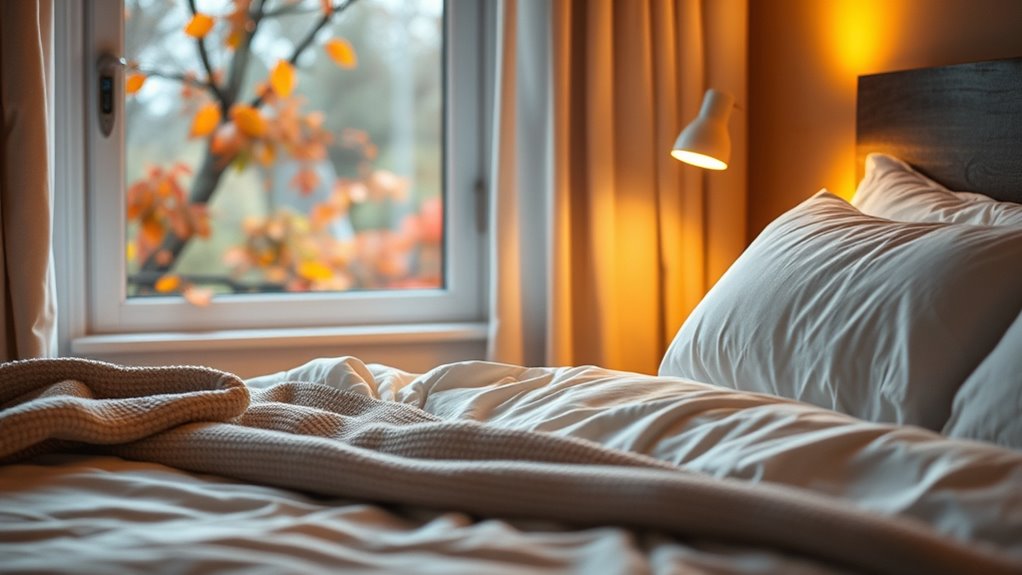
When traveling or experiencing seasonal changes, adjusting your sleep environment’s temperature becomes essential to maintaining restful sleep. Climate adaptation is key—what works at home may not suit new conditions. To stay comfortable, use travel sleep tips like packing a portable fan or a cooling/hot pack to help regulate your body temperature. If you’re in a warmer climate, lower the room temperature or use breathable bedding to prevent overheating. In colder seasons, add extra blankets or use a heated blanket to stay warm without overheating. Keep your sleep space well-ventilated, and consider a humidifier if dry air affects your comfort. These adjustments help your body adapt quickly, ensuring restful sleep regardless of season or location.
The Role of Bedding and Sleepwear in Temperature Regulation

Bedding and sleepwear play a crucial role in maintaining a comfortable body temperature throughout the night. The right bedding materials and sleepwear fabrics can help you stay cool or warm, depending on your needs. Consider these factors:
- Choose breathable bedding materials like cotton or linen to wick away moisture and promote airflow.
- Opt for sleepwear fabrics such as bamboo or lightweight cotton to prevent overheating.
- Use layered bedding to easily adjust insulation—add or remove blankets as needed.
- Avoid synthetic fabrics that trap heat and moisture, disrupting your sleep comfort.
Technological Tools to Maintain Your Perfect Sleep Climate

Technological tools have become essential in maintaining your ideal sleep climate by allowing precise control over temperature and humidity. Smart thermostats enable you to set and automatically adjust your bedroom’s temperature for optimal comfort throughout the night. They can learn your preferences and adapt to changing conditions, ensuring consistent sleep conditions. Sleep tracking devices, such as wearable sensors or mattress monitors, provide insights into your sleep patterns and environment. Some systems even integrate with smart thermostats to fine-tune your bedroom climate based on your sleep quality. These tools help you identify patterns, maximize your environment, and maintain the perfect temperature for restful sleep. With these technologies, you can create a personalized sleep sanctuary that promotes better rest and overall wellness.
Recognizing Signs Your Sleep Environment Isn’t Optimal
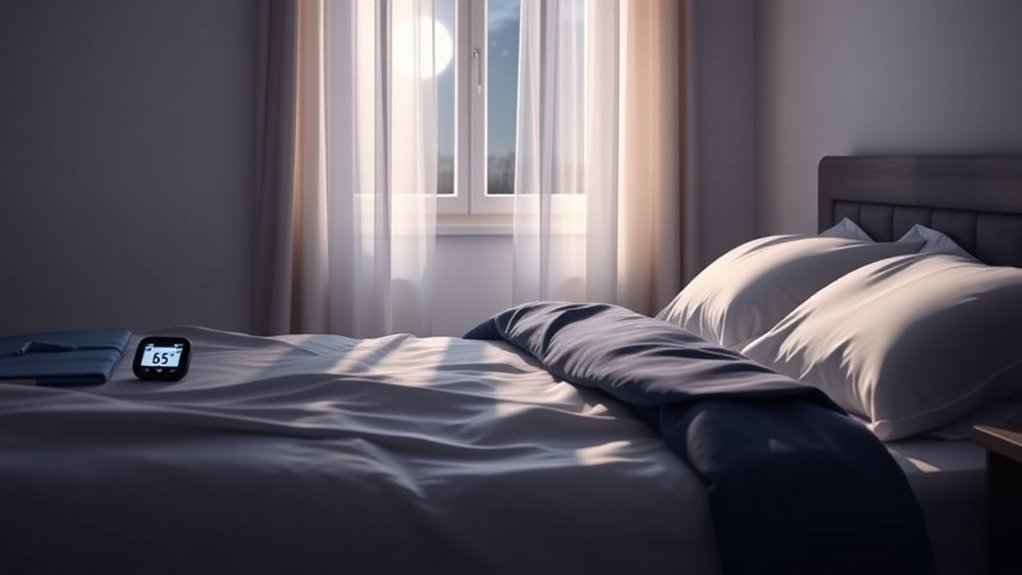
If you’re consistently waking up feeling tired or restless, it might be a sign that your sleep environment isn’t ideal. Pay attention to these signs:
- Your sleep position feels uncomfortable or causes aches, indicating poor mattress support or temperature issues.
- You wake up sweaty or clammy, suggesting bedroom humidity is too high.
- You experience dry skin or throat, often linked to low humidity levels.
- You notice frequent tossing and turning, which may mean your room isn’t cool enough or your sleep environment isn’t properly ventilated.
These signs point to an environment that may not support restful sleep. Adjusting bedroom humidity, optimizing your sleep position, and ensuring proper airflow can make a significant difference.
Frequently Asked Questions
How Does Humidity Influence Optimal Sleep Temperature?
Humidity influences your sleep temperature by affecting moisture control and humidity regulation. When humidity is too high, your body struggles to cool down, making it feel warmer and disrupting deep sleep stages. Conversely, low humidity can cause dryness, leading to discomfort and difficulty staying asleep. Maintaining ideal humidity levels helps your body regulate temperature naturally, ensuring you stay comfortable and achieve restful sleep throughout the night.
Can Sleep Temperature Affect REM Sleep Duration?
Your sleep temperature can substantially impact your REM sleep duration. When your bedroom climate is too warm or cold, it disrupts your sleep cycle, making it harder to reach and maintain REM stages. Maintaining an ideal sleep temperature helps your body stay comfortable, allowing your sleep cycle to progress smoothly. By controlling your bedroom climate, you support longer REM periods, which are essential for mental and physical restoration.
What Are the Long-Term Health Effects of Sleeping in Incorrect Temperatures?
Imagine your body’s thermostat as a delicate balance beam—you tip it wrong, and long-term health suffers. Sleeping in incorrect temperatures can cause thermoregulation issues, disrupting your sleep quality and leading to chronic fatigue, weakened immunity, and increased stress. Over time, these effects may raise your risk for heart disease and diabetes. Prioritize a consistent, ideal sleep environment to protect your health and keep your body’s balance intact.
How Do Age and Gender Impact Ideal Sleep Temperature?
Your ideal sleep temperature varies with age and gender, as age-related comfort needs change and gender-specific preferences influence temperature sensitivity. Younger people often sleep better in slightly cooler environments, while older adults may prefer warmer settings for joint comfort. Women may favor slightly warmer temperatures due to hormonal fluctuations, while men tend to prefer cooler rooms. Adjust your sleep environment accordingly to optimize comfort and improve sleep quality.
Are There Specific Temperature Considerations for Sleep Disorders Like Insomnia?
If you have a sleep disorder like insomnia, focus on creating a sleep environment that promotes proper temperature regulation. Keep your bedroom at a comfortable, slightly cool temperature, around 60-67°F (15-19°C), to help your body relax and fall asleep faster. Avoid overheating or excessive cold, as these disrupt sleep. Adjust your bedding and room temperature as needed to maintain ideal conditions, supporting your sleep quality and overall wellness.
Conclusion
Finding the perfect sleep temperature is like tuning a delicate instrument—you’ll hit the sweet spot where your body can relax and drift effortlessly into restful dreams. By understanding how temperature influences your sleep cycles and making small adjustments, you create a cozy sanctuary that whispers tranquility. Think of it as crafting your personal oasis, where comfort wraps around you like a warm blanket, guiding you gently into the peaceful night you deserve.
